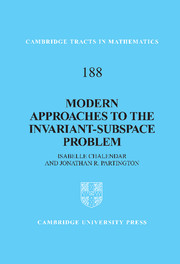Book contents
- Frontmatter
- Contents
- Preface
- 1 Background
- 2 The operator-valued Poisson kernel and its applications
- 3 Properties (An,m) and factorization of integrable functions
- 4 Polynomially bounded operators with rich spectrum
- 5 Beurling algebras
- 6 Applications of a fixed-point theorem
- 7 Minimal vectors
- 8 Universal operators
- 9 Moment sequences and binomial sums
- 10 Positive and strictly-singular operators
- References
- Index
7 - Minimal vectors
Published online by Cambridge University Press: 07 October 2011
- Frontmatter
- Contents
- Preface
- 1 Background
- 2 The operator-valued Poisson kernel and its applications
- 3 Properties (An,m) and factorization of integrable functions
- 4 Polynomially bounded operators with rich spectrum
- 5 Beurling algebras
- 6 Applications of a fixed-point theorem
- 7 Minimal vectors
- 8 Universal operators
- 9 Moment sequences and binomial sums
- 10 Positive and strictly-singular operators
- References
- Index
Summary
In this chapter we present a construction proposed in the late 1990s by Ansari and Enflo [11] in a Hilbert space context; this was used to show the existence of hyperinvariant subspaces for various classes of operators, and in particular to give new proofs of their existence in the the cases of compact operators and normal operators. Although it was first presented as a Hilbert space construction, it was soon developed further by other authors and extended to general Banach spaces.
The basic idea is that with an operator, a given vector and a parameter, one associates a sequence of ‘minimal’ vectors, and, broadly speaking, if this sequence converges one can deduce the existence of hyperinvariant subspaces.
We shall now present the construction of minimal vectors and its application to various classes of operators, including weighted composition operators and weighted shifts, in addition to the more standard operators considered by Ansari and Enflo. En route we shall also consider the constrainedapproximation problem that needs to be solved if one is to obtain explicit formulae for minimal vectors, since it can be put into a more general context which has applications in other areas of analysis.
The basic definitions
Let χ be a real or complex Banach space, and T ∈ ℒ(χ) be injective with dense range.
- Type
- Chapter
- Information
- Modern Approaches to the Invariant-Subspace Problem , pp. 183 - 212Publisher: Cambridge University PressPrint publication year: 2011



